Solubility of nifedipine in twenty-one mono-solvents at various temperatures
IF 2.7
3区 工程技术
Q3 CHEMISTRY, PHYSICAL
引用次数: 0
Abstract
This study evaluated the solubility of nifedipine in various mono-solvents at temperatures ranging from 293.2 K to 313.2 K and correlating the data with mathematical models. Tetrahydrofuran exhibited the highest solubility at 313.2 K, while 1-octanol showed the lowest at 293.2 K among investigated solvent systems. Polar aprotic solvents showed enhanced solubility, whereas non-polar solvents demonstrated poor solubility. The generated solubility data was mathematically represented using a number of algorithms. An extended version of a previously proposed model provided the best correlation between solubility and the physicochemical properties of the solvents. The obtained mean percentage deviation of this model was 9.89 % (N = 99). Empirical models based on Hildebrand and Hansen solubility parameters provided more accurate predictions particularly for aromatic and polar aprotic solvents. In conclusion, the extended model effectively predicted nifedipine solubility, highlighting the critical role of solvent selection and temperature in enhancing solubility. These findings provide valuable insights for optimizing pharmaceutical processes and improving drug extraction/purification systems and could be recommended for industrial applications.
硝苯地平在21种单溶剂中不同温度下的溶解度
研究了硝苯地平在293.2 ~ 313.2 K温度下的溶解度,并建立了数学模型。四氢呋喃在313.2 K时溶解度最高,而辛醇在293.2 K时溶解度最低。极性非质子溶剂的溶解度增强,而非极性溶剂的溶解度较差。生成的溶解度数据使用许多算法在数学上表示。先前提出的模型的扩展版本提供了溶解度和溶剂的物理化学性质之间的最佳相关性。所得模型的平均百分比偏差为9.89% (N = 99)。基于Hildebrand和Hansen溶解度参数的经验模型提供了更准确的预测,特别是对芳香和极性非质子溶剂。综上所述,扩展模型有效地预测了硝苯地平的溶解度,突出了溶剂选择和温度对提高溶解度的关键作用。这些发现为优化制药工艺和改进药物提取/纯化系统提供了有价值的见解,并可推荐用于工业应用。
本文章由计算机程序翻译,如有差异,请以英文原文为准。
求助全文
约1分钟内获得全文
求助全文
来源期刊

Fluid Phase Equilibria
工程技术-工程:化工
CiteScore
5.30
自引率
15.40%
发文量
223
审稿时长
53 days
期刊介绍:
Fluid Phase Equilibria publishes high-quality papers dealing with experimental, theoretical, and applied research related to equilibrium and transport properties of fluids, solids, and interfaces. Subjects of interest include physical/phase and chemical equilibria; equilibrium and nonequilibrium thermophysical properties; fundamental thermodynamic relations; and stability. The systems central to the journal include pure substances and mixtures of organic and inorganic materials, including polymers, biochemicals, and surfactants with sufficient characterization of composition and purity for the results to be reproduced. Alloys are of interest only when thermodynamic studies are included, purely material studies will not be considered. In all cases, authors are expected to provide physical or chemical interpretations of the results.
Experimental research can include measurements under all conditions of temperature, pressure, and composition, including critical and supercritical. Measurements are to be associated with systems and conditions of fundamental or applied interest, and may not be only a collection of routine data, such as physical property or solubility measurements at limited pressures and temperatures close to ambient, or surfactant studies focussed strictly on micellisation or micelle structure. Papers reporting common data must be accompanied by new physical insights and/or contemporary or new theory or techniques.
 求助内容:
求助内容: 应助结果提醒方式:
应助结果提醒方式:


